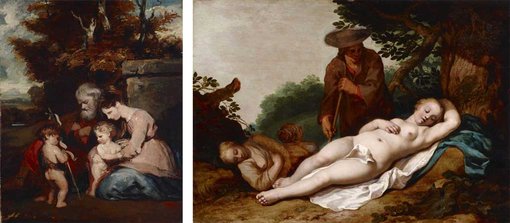Kenneth Reed bequest
Philanthropist and arts patron announces his significant bequest to the Gallery

Left: Joshua Reynolds, The Holy Family c1790; right: Abraham Bloemart, Cimon and Phigenia late 1620s. Both Collection Kenneth Reed
Kenneth Reed today announced his intention to bequeath to the Art Gallery of New South Wales a substantial collection of old master paintings, Italian Maiolica and European 18th-century porcelain.
Numbering over 70 items in total the Ken Reed bequest will represent a most significant addition to the gallery’s European collection said Edmund Capon, Director, Art Gallery of New South Wales.
Mr Reed, a Sydney-based retired lawyer, has been a collector of European fine and decorative arts for some 25 years. He says that he was inspired by visits as a child to the Art Gallery of New South Wales where his father used to take the family on Sunday afternoons. The Art Gallery is to receive 25 old master paintings, 25 pieces of 18th-century porcelain and 22 pieces of 16th-17th century Italian maiolica.
Some of the pictures could have been specifically selected to complement those already in the Gallery’s collection. Abraham Bloemaert’s Cimon and Iphigenia, for example, represents a 17th-century Dutch take on a story famously represented by Lord Leighton in his late masterpiece in the Sydney collection. Its subject matter also echoes Jacques Blanchard’s superlative Mars and the Vestal Virgin which the gallery acquired in 2008.
There are several pictures which will complement the collection. A great Dutch banquet still life by Abraham van Beyeren will become one of the greatest still life paintings in the gallery’s collection said Richard Beresford, Senior Curator of European Art.
The absence of any major example of Roman Baroque painting has now been brought to an end as the Gallery is to receive Andrea Camassei’s finished sketch (or modello) for an altarpiece in St Peter’s , Rome showing St Peter baptising Sts Processus and Martinian. The Gallery’s representation of the British school will also be transformed by the addition of portraits by Lely, Romney and Hoppner none of whom were previously represented in the collection. The Hoppner is also an important addition as it represents the famous French dancer Mlle Hilligsberg who enchanted London audiences in the late-18th and early-19th centuries.
The Gallery has minimal holdings of European decorative arts. The decision to display 16th-18th century ceramics alongside paintings of the same period will add a new dimension to the Gallery’s collection said Richard Beresford.
The Italian maiolica includes a superb Urbino ‘istoriato’ plate representing a scene from Roman history (Gaius Popilius Laenas before the King of Syria) dating from about 1545. Urbino plates of this kind (ie decorated with a single painted scene covering the whole upper surface) represent the height of sophistication in Italian Renaissance ceramics. The Reed collection also includes a superb two-handled vase of c 1530-40 with the gold lustre decoration characteristic of Deruta. There are examples of wares from Montelupo, Pesaro, Faenza, Venice and Castelli d’Abruzzo.
The porcelain represents a selection of early porcelain including important examples of the main German, French and English factories: Meissen, Vincennes-Sèvres and Chelsea. Among the highlights are an extremely rare and important Sèvres tea service of 1762 and an exquisite small white goat-and-bee jug from Chelsea, which is one of earliest pieces of porcelain produced in England.
The pictures are to remain on show in the Gallery’s old courts until 16 January 2011 and will then return to Mr Reed until the bequest takes effect. The ceramics will remain on show.
Media contact
Susanne Briggs
Tel 02 9225 1791
Mob 0412 268 320
susanne.briggs@ag.nsw.gov.au